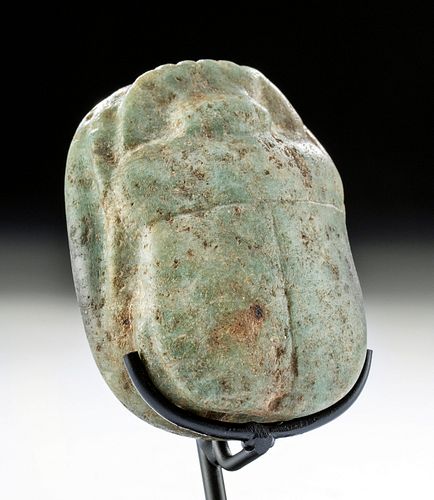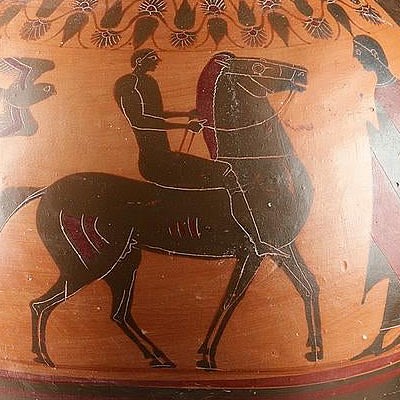Egyptian Late Dynastic Jadeite Heart Scarab, ex-Mitry
Lot 13b
About Seller
Artemis Fine Arts
686 S Taylor Ave, Ste 106
Louisville, CO 80027
United States
Selling antiquities, ancient and ethnographic art online since 1993, Artemis Gallery specializes in Classical Antiquities (Egyptian, Greek, Roman, Near Eastern), Asian, Pre-Columbian, African / Tribal / Oceanographic art. Our extensive inventory includes pottery, stone, metal, wood, glass and textil...Read more
Estimate:
$2,500 - $4,000
Absentee vs Live bid
Two ways to bid:
- Leave a max absentee bid and the platform will bid on your behalf up to your maximum bid during the live auction.
- Bid live during the auction and your bids will be submitted real-time to the auctioneer.
Bid Increments
| Price | Bid Increment |
|---|---|
| $0 | $25 |
| $300 | $50 |
| $1,000 | $100 |
| $2,000 | $250 |
| $5,000 | $500 |
| $10,000 | $1,000 |
| $20,000 | $2,500 |
| $50,000 | $5,000 |
| $100,000 | $10,000 |
| $200,000 | $20,000 |
About Auction
By Artemis Fine Arts
Jun 4, 2020
Set Reminder
2020-06-04 10:00:00
2020-06-04 10:00:00
America/New_York
Bidsquare
Bidsquare : Exceptional Antiquities, Asian, Ethnographic
https://www.bidsquare.com/auctions/artemis-gallery/exceptional-antiquities-asian-ethnographic-5185
An important one-day auction featuring museum-worthy examples of Egyptian, Greek, Roman, Etruscan, Near Eastern, Far East / Asian, Pre-Columbian, African / Tribal, Oceanic, Native American, Spanish Colonial, Russian, Fossils, Ancient Jewelry, Fine Art, so much more! Artemis Fine Arts info@artemisfinearts.com
An important one-day auction featuring museum-worthy examples of Egyptian, Greek, Roman, Etruscan, Near Eastern, Far East / Asian, Pre-Columbian, African / Tribal, Oceanic, Native American, Spanish Colonial, Russian, Fossils, Ancient Jewelry, Fine Art, so much more! Artemis Fine Arts info@artemisfinearts.com
- Lot Description
Egypt, Late Dynastic Period, 26th to 31st Dynasty, ca. 664 to 332 BCE. A gorgeous insectile amulet of a heart scarab that is hand-carved from mottled forest-green jadeite with brown and beige inclusions. The stocky beetle lays recumbent atop an integral ovoid plinth with sinuous legs retracted beneath its bulky wing carapace, and incised striations create frilled serrations on the face and legs as well as delineate the individual wings. While the underside of the amulet is uninscribed, traces of black pigment suggest an inscription or protective symbol was painted on prior to burial. The lack of a suspension hole also furthers the notion that this was meant as a highly symbolic funerary offering, perhaps from a widow for her deceased husband. A sizable example flaunting smooth surfaces and fine form. Size: 2.2" L x 1.625" W x 0.8" H (5.6 cm x 4.1 cm x 2 cm); 2.9" H (7.4 cm) on included custom stand.
The ancient Egyptians believed that a person's heart contained the undeniable and absolute proof of how an individual's actions in life - whether benevolent, miserly, or otherwise - determined the type of afterlife they could experience. No one could claim to have lived a life entirely free of sin, though their noble beliefs and actions enabled them to tend the field of Osiris in the afterlife. Though full of challenging trials and tribulations, the final obstacle in one's journey through the afterlife was to be judged at the Court of Osiris in a ceremony known as the 'weighing of the heart.' In this ceremony, the heart of the deceased was removed by the Anubis, the jackal-headed god of the dead and the process of embalming, against a single feather of Ma'at (or feather of truth). If the weight of the heart was less than that of the feather, the gods of the Court would effectively decree that the deceased had lived a life worthy of the resplendence of Osiris' fields. If the heart weighed even a gram heavier than the feather, their heart was fed to Ammit (also Ammat), a horrifying chimeric beast with the head of a crocodile, the body of a leopard, and the latter half of a hippopotamus' body. An individual's worst fear during this ceremony was that their heart will speak out against them during the final judgement. In order combat this anxiety, the living spouses of the deceased would carve heart scarabs like this example and inscribe them with a specific protective incantation from Chapter 30B of the Egyptian Book of the Dead (or the Book of Going Forth by Day) to silence any final wickedness one's heart could muster and ensure their entrance into the Fields of Osiris in the afterlife.
For a strikingly similar example with a base inscription, please see The Metropolitan Museum of Art, accession number 10.130.1650
Another stylistically similar example, of a smaller size and carved from serpentine, hammered for $13,750 at Christie's, New York "Antiquities" auction (sale 3798, December 9, 2015, lot 184).
Provenance: ex-Phillip Mitry collection, noted antiquities dealer in Cairo, Egypt before emigrating to the United States in 1951
All items legal to buy/sell under U.S. Statute covering cultural patrimony Code 2600, CHAPTER 14, and are guaranteed to be as described or your money back.
A Certificate of Authenticity will accompany all winning bids.
We ship worldwide and handle all shipping in-house for your convenience.
#153954Minor nicks and abrasions to top, peripheries, and base, with fading to incised details, and fading to most original pigment, otherwise intact and excellent. Light earthen deposits and smooth surface texture throughout. Faint but visible remains of original black pigment on underside.Condition
- Shipping Info
-
All shipping is handled in-house for your convenience. Your invoice from Artemis Gallery will include shipping calculation instructions. If in doubt, please inquire BEFORE bidding for estimated shipping costs for individual items.
-
- Buyer's Premium



 EUR
EUR CAD
CAD AUD
AUD GBP
GBP MXN
MXN HKD
HKD CNY
CNY MYR
MYR SEK
SEK SGD
SGD CHF
CHF THB
THB















